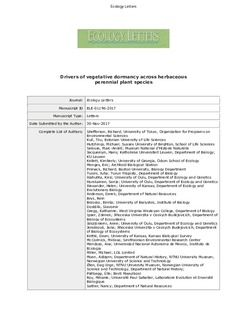| dc.contributor.author | Shefferson, Richard P. | |
| dc.contributor.author | Kull, Tiiu | |
| dc.contributor.author | Hutchings, Michael J. | |
| dc.contributor.author | Selosse, Marc-André | |
| dc.contributor.author | Jacquemyn, Hans | |
| dc.contributor.author | Kellett, Kimberly M. | |
| dc.contributor.author | Menges, Eric S. | |
| dc.contributor.author | Primack, Richard B. | |
| dc.contributor.author | Tuomi, Juha | |
| dc.contributor.author | Alahuhta, Kirsi | |
| dc.contributor.author | Hurskainen, Sonja | |
| dc.contributor.author | Alexander, Helen M. | |
| dc.contributor.author | Anderson, Derek S. | |
| dc.contributor.author | Brys, Rein | |
| dc.contributor.author | Brzosko, Emilia | |
| dc.contributor.author | Dostálik, Slavomir | |
| dc.contributor.author | Gregg, Katharine | |
| dc.contributor.author | Ipser, Zdenek | |
| dc.contributor.author | Jäkäläniemi, Anne | |
| dc.contributor.author | Jersáková, Jana | |
| dc.contributor.author | Kettle, W. Dean | |
| dc.contributor.author | McCormick, Melissa | |
| dc.contributor.author | Mendoza, Ana | |
| dc.contributor.author | Miller, Michael T. | |
| dc.contributor.author | Moen, Asbjørn | |
| dc.contributor.author | Øien, Dag-Inge | |
| dc.contributor.author | Püttsepp, Ülle | |
| dc.contributor.author | Roy, Mélanie | |
| dc.contributor.author | Sather, Nancy | |
| dc.contributor.author | Sletvold, Nina | |
| dc.contributor.author | Stípková, Zuzana | |
| dc.contributor.author | Tali, Kadri | |
| dc.contributor.author | Warren, Robert J. II | |
| dc.contributor.author | Whigham, Dennis F. | |
| dc.date.accessioned | 2019-02-12T09:09:29Z | |
| dc.date.available | 2019-02-12T09:09:29Z | |
| dc.date.created | 2018-11-08T20:44:44Z | |
| dc.date.issued | 2018 | |
| dc.identifier.citation | Ecology Letters. 2018, 21 724-733. | nb_NO |
| dc.identifier.issn | 1461-023X | |
| dc.identifier.uri | http://hdl.handle.net/11250/2584945 | |
| dc.description.abstract | Vegetative dormancy, that is the temporary absence of aboveground growth for ≥ 1 year, is paradoxical, because plants cannot photosynthesise or flower during dormant periods. We test ecological and evolutionary hypotheses for its widespread persistence. We show that dormancy has evolved numerous times. Most species displaying dormancy exhibit life‐history costs of sprouting, and of dormancy. Short‐lived and mycoheterotrophic species have higher proportions of dormant plants than long‐lived species and species with other nutritional modes. Foliage loss is associated with higher future dormancy levels, suggesting that carbon limitation promotes dormancy. Maximum dormancy duration is shorter under higher precipitation and at higher latitudes, the latter suggesting an important role for competition or herbivory. Study length affects estimates of some demographic parameters. Our results identify life historical and environmental drivers of dormancy. We also highlight the evolutionary importance of the little understood costs of sprouting and growth, latitudinal stress gradients and mixed nutritional modes. | nb_NO |
| dc.language.iso | eng | nb_NO |
| dc.publisher | Wiley | nb_NO |
| dc.title | Drivers of vegetative dormancy across herbaceous perennial plant species | nb_NO |
| dc.title.alternative | Drivers of vegetative dormancy across herbaceous perennial plant species | nb_NO |
| dc.type | Journal article | nb_NO |
| dc.description.version | submittedVersion | nb_NO |
| dc.source.pagenumber | 724-733 | nb_NO |
| dc.source.volume | 21 | nb_NO |
| dc.source.journal | Ecology Letters | nb_NO |
| dc.identifier.doi | 10.1111/ele.12940 | |
| dc.identifier.cristin | 1628517 | |
| dc.description.localcode | This is the pre-peer reviewed version of an article, which has been published in final form at [https://doi.org/10.1111/ele.12940]. This article may be used for non-commercial purposes in accordance with Wiley Terms and Conditions for Self-Archiving. | nb_NO |
| cristin.unitcode | 194,31,10,0 | |
| cristin.unitname | Institutt for naturhistorie | |
| cristin.ispublished | true | |
| cristin.fulltext | preprint | |
| cristin.qualitycode | 2 | |
